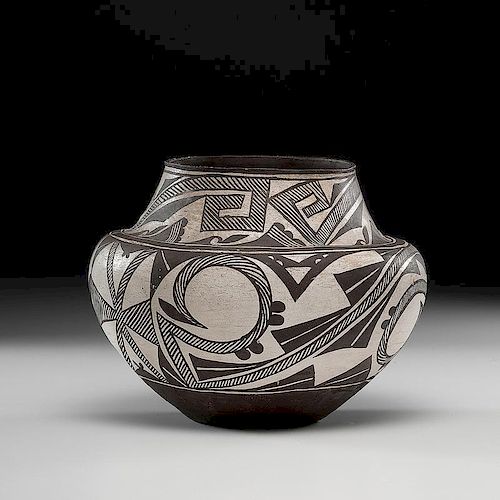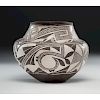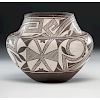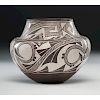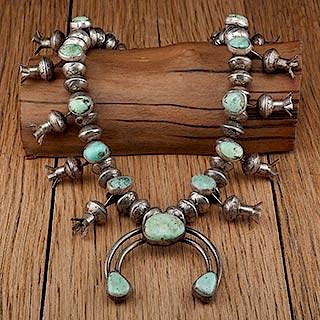Laguna Pottery Olla Attributed to Arroh-ah-och
About Seller
6270 Este Ave.
Cincinnati , OH 45232
United States
With offices in Cincinnati, Cleveland and Denver, Cowan’s holds over 40 auctions each year, with annual sales exceeding $16M. We reach buyers around the globe, and take pride in our reputation for integrity, customer service and great results. A full-service house, Cowan’s Auctions specializes in Am...Read more
Two ways to bid:
- Leave a max absentee bid and the platform will bid on your behalf up to your maximum bid during the live auction.
- Bid live during the auction and your bids will be submitted real-time to the auctioneer.
Bid Increments
| Price | Bid Increment |
|---|---|
| $0 | $25 |
| $500 | $50 |
| $1,000 | $100 |
| $2,000 | $250 |
| $5,000 | $500 |
| $10,000 | $1,000 |
| $20,000 | $2,500 |
| $50,000 | $5,000 |
| $100,000 | $10,000 |
About Auction
Apr 8, 2017 - Apr 9, 2017
Cowan's Auctions dawnie@cowans.com
- Lot Description
concave base, strong shoulder, and slightly flared rim; designed with hatched geometrics and solid foliate elements, height 9.25 in. x diameter 11.5 in.
ca 1890-1900
Attribution provided by Robert Bauver:
In the pre-1900, pueblos of the American Southwest it was not altogether uncommon for some men to adopt the ways and dress of women. These men women known as "berdaches" or "amujerados" were often highly respected individuals in the pueblos rivaling their female counterparts in the women's arts including the production of pottery. One such individual named Arroh-ah-och was a resident of Laguna Pueblo.
Working in a Zuni style, using Laguna clay and paints, Arroh-ah-och created a distinctive pottery type that has been mislabeled as Zuni over the years by scholars, collectors, and museums. To the practiced eye, these pots differ from those produced at Zuni not only in materials used but in the design layout as well.
In her extensive study of early 20th century pueblo pottery, ethnographer Ruth Bunzel states that Zuni potters were very specific regarding how and where certain designs could be used on a pot. Explaining that certain designs were only appropriate for use on the neck or body of a jar, these design elements could never be transposed. Not being subject to these restrictions, Arroh-ah-och often used elements in ways that would haves shocked any self respecting Zuni pottery. In point of fact, the author owns a small water jar by the artist described here that has a neck design a motif the Zuni reserved exclusively for the interior rim of open bowls. Zuni design elements often showing some slight personal modifications would become a standard on pottery by this artist.
In the case of this olla, the artist exhibits the full extent of his innovative skills and mastery of his craft. Made with local materials, the overall shape is essentially Zuni, flaring up from a small base to a flaring shoulder that actually rolls over slightly before continuing up the tapering neck. It is important to note here that the neck is taller than those usually found at Zuni and is more characteristic of Laguna.
Forming a border along the upper framing line that circles the neck is a series of design elements that are based on a common Zuni motif. This particular element, to which a feather or leaf-like device have been added at the terminus of the small crook (unique to this potter) appears on several pots made by Arroh-ah-och. One is pictures in Jonathan Batkin's book, "Pottery of the Pueblos of New Mexico", on page 150 where they appear on either side of the deer in the upper tier of design on the main body of the jar. They are present again on his largest and probably best known jar which can be seen in "Acoma and Laguna Pottery" by Rick Dillingham on page 13. Here, they are paired as elements forming the central rosette motif on the jar. Between these paired elements is a stepped triangle within a triangle repeated in slight variation on this jar in two places on the lower of the shoulder's framing lines.
The larger hatched devices using in variation on both the neck and body of this jar are possibly the most interesting and overlooked. They are a true marriage of Zuni and Laguna design concepts merged and used in such a harmony that neither aspect of the pueblo on whose design history they are drawn from outweighs the other.The practice of painting the base of jars black instead of the more commonly seen red is a characteristic exclusive to Zuni and used here in deference to that pueblo. The most interesting aspect here is the indented base has been left unpainted revealing the true nature of the clay and in this case the artist as well.
Robert Bauver
June 2003 - Shipping Info
-
SHIPPING. At the request of the buyer, Cowan's will authorize the shipment of purchased items. Shipments usually occur within two weeks after payment has been received. Shipment is generally made via UPS Ground service. Unless buyer gives special instructions, the shipping method shall be at the sole discretion of Cowan's Auctions, Inc.. Cowan's is in no way responsible for the acts or omissions of independent handlers, packers or shippers of purchased items or for any loss, damage or delay from the packing or shipping of any property.
-
- Buyer's Premium



 EUR
EUR CAD
CAD AUD
AUD GBP
GBP MXN
MXN HKD
HKD CNY
CNY MYR
MYR SEK
SEK SGD
SGD CHF
CHF THB
THB